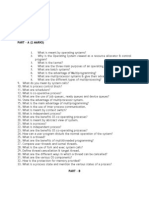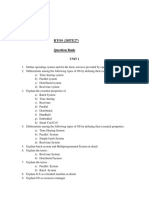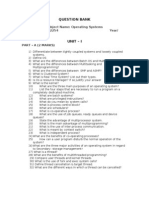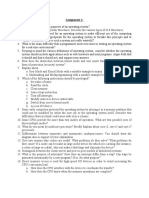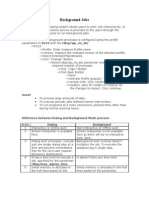0 ratings0% found this document useful (0 votes)
13 viewsOperating System (1)
Uploaded by
avniCopyright
© © All Rights Reserved
Available Formats
Download as PDF, TXT or read online on Scribd
0 ratings0% found this document useful (0 votes)
13 viewsOperating System (1)
Uploaded by
avniCopyright
© © All Rights Reserved
Available Formats
Download as PDF, TXT or read online on Scribd
You are on page 1/ 5
Kanoria PG Mahila Mahavidyalaya, Jaipur
Department of Computer Science
Operating System 203
BCA II
Question Bank
1. What are the objectives of operating system?
2. What are the advantages of peer-to-peer systems over client-server systems?
3. What is the purpose of system programs/system calls?
4. How does an interrupt differ from a trap?
5. What are disadvantages of multi-processor systems?
6. Defend timesharing differ from multiprogramming? If so, how?
7. Why API’s need to be used rather than system call?
8. Compare and contrast DMA and cache memory.
9. Distinguish between batch systems and time sharing systems.
10. What is real time system?
11. What do you mean by system calls?
12. Define process.
13. What is process control block?
14. What is scheduler?
15. What are the use of job queues, ready queues and device queues?
16. What is meant by context switch?
17. What is the main advantage of multiprogramming?
18. Discuss the main advantages of layered approach to system design?
19. List the advantage of multiprocessor system?
20. Define inter process communication.
21. Identify the difference between mainframe and desktop operating system.
22. What is bootstrap program?
23. Illustrate the different interrupt clauses.
24. Identify what virtual machine is and what are the advantages virtual machines.
25. Summarize the functions of DMA.
26. Illustrate the use of fork and exec system calls.
27. What are the three main purposes of an operating system?
28. What is the purpose of system calls?
29. What are the five major activities of an operating system with regard to process management?
30. What are the three major activities of an operating system with regard to memory management?
31. What are the three major activities of an operating system with regard to secondary- storage
management?
32. What is an Operating system?
33. List the services provided by an Operating System?
34. What is the Kernel?
35. What is meant by Mainframe Systems?
36. What is Multiprocessor System?
37. What are the advantages of multiprocessors?
38. What is meant by Batch Systems?
39. What are the basic functions of OS and DMA?
40. Explain the concept of multiprocessor and Multicore organization.
41. Discuss in detail about Distributed systems.
42. Demonstrate the three methods for passing parameters to the OS with examples.
43. Explain how protection is provided for the hardware resources by the operating system.
44. List the various services provided by operating systems.
45. Discuss the DMA driven data transfer technique.
46. Discuss about the evolution of virtual machines.
47. Compare and contrast Single-threaded and multi-threaded process.
48. Distinguish between CPU bounded, I/O bounded processes.
49. List out the data fields associated with process control blocks.
50. What is a thread?
51. Define CPU Scheduling.
52. Distinguish between preemptive and non- preemptive Scheduling.
53. List the functions of Dispatcher Module.
54. What are the various scheduling criteria for CPU scheduling?
55. What are the requirements that a solution to the critical section problem must satisfy?
56. Define Critical section problem.
57. How will you calculate turn-around time?
58. Name two hardware instructions and their definitions which can be used for implementing mutual
exclusion.
59. What is a semaphore?
60. Define Deadlock.
61. What are the conditions under which a deadlock situation may arise?
62. What are the methods for handling deadlocks?
63. What are the benefits of synchronous and asynchronous communication?
64. Define process?
65. What is meant by the state of the process?
66. Define process control block contain?
67. What are the 3 different types of scheduling queues?
68. Define schedulers?
69. What are the types of scheduler?
70. Define critical section?
71. Define Starvation in deadlock?
72. Name some classic problem of synchronization?
73. Give the condition necessary for a deadlock situation to arise?
74. Define ‘Safe State”?
75. Define race condition.
76. Define entry section and exit section.
77. Explain the difference between preemptive and nonpreemptive scheduling.
78. State critical section problem? Discuss three solutions to solve the critical section problem.
79. Distinguish among short-term, medium-term and long-term scheduling with suitable example.
80. Explain the differences in the degree to which the following scheduling algorithms deiscriminate in
favour of short processes: RR, Multilevel Feedback Queues/
81. Discuss how the following pairs of scheduling criteria conflict in certain settings.
82. Write about the various CPU scheduling algorithms.
83. Write about critical regions and monitors.
84. How can deadlock be detected?
85. Write notes about multiple-processor scheduling and real-time scheduling.
86. Define: Belady’s anomaly?
87. What is the purpose of paging the page table?
88. List two differences between logical and physical addresses.
89. What are the steps required to handle a page fault in demand paging?
90. What do you meant by thrashing?
91. Explain dynamic loading.
92. Explain dynamic Linking.
93. Define Overlays.
94. Define swapping.
95. What is Demand Paging?
96. What is pure demand paging?
97. Outline about virtual memory.
98. What are the common strategies to select a free hole from a set of available holes?
99. Distinguish between page and segment.
100. How the problem of external fragmentation can be solved.
101. Define Address binding.
102. List the steps needed to handle page fault.
103. What are the counting based page replacement algorithm?
104. How is memory protected in a paged environment?
105. What are the major problems to implement Demand Paging?
106. What are Pages and Frames?
107. What is the basic method of Segmentation?
108. Define Secondary Memory.
109. What is the basic approach of Page Replacement?
110. What is the various Page Replacement Algorithms used for Page Replacement?
111. What do you mean by Best Fit?
112. Explain about given memory management techniques
113. When page faults will occur? Describe the actions taken by operating system during page fault
114. Distinguish file from dictionary.
115. Define C-SCAN scheduling.
116. List the various file attributes.
117. What are the functions of Virtual File System (VFS) layer in file system implementation?
118. What is a file?
119. What are the various file operations?
120. List the operations that can be performed on a directory.
121. Determine the most common schemes for defining the logical structure of a directory?
122. What are the allocation methods of a disk space?
123. Define seek time and latency time.
124. Define rotational latency and disk bandwidth.
125. Define Spooling.
126. What are the various disk-scheduling algorithms?
127. List three ways of allocating storage, and give advantages of each.
128. What are the advantages of Contiguous Allocation?
129. What are the drawbacks of Contiguous Allocation of Disk Space?
130. Explain about directory structure
You might also like
- (Overview) Most Asked OS Questions by Neha and NehalNo ratings yet(Overview) Most Asked OS Questions by Neha and Nehal11 pages
- OS - Operating System Interview Questions and Answers For Freshers PDFNo ratings yetOS - Operating System Interview Questions and Answers For Freshers PDF3 pages
- Operating System UNIT I (Question Bank) Part-ANo ratings yetOperating System UNIT I (Question Bank) Part-A7 pages
- Top 50 Operating System Interview Questions: 1) Explain The Main Purpose of An Operating System?No ratings yetTop 50 Operating System Interview Questions: 1) Explain The Main Purpose of An Operating System?11 pages
- Operating System Model Question Bank(24-25) (1) (Repaired)No ratings yetOperating System Model Question Bank(24-25) (1) (Repaired)7 pages
- Anna University Department of Computer Science and EngineeringNo ratings yetAnna University Department of Computer Science and Engineering9 pages
- Operating System Interview Questions With AnswersNo ratings yetOperating System Interview Questions With Answers12 pages
- OS Computer Science Engineering B-TECH 4th - PTU Very Short QuestionsNo ratings yetOS Computer Science Engineering B-TECH 4th - PTU Very Short Questions2 pages
- Gandhinagar Institute of Technology: Computer Engineering DepartmentNo ratings yetGandhinagar Institute of Technology: Computer Engineering Department6 pages
- Semester:-Sem IV Branch: - Computer Science and Engineering Subject: - Operating SystemNo ratings yetSemester:-Sem IV Branch: - Computer Science and Engineering Subject: - Operating System14 pages
- Foundations of Computing: Essential for Computing Studies, Profession And Entrance Examinations - 5th EditionFrom EverandFoundations of Computing: Essential for Computing Studies, Profession And Entrance Examinations - 5th EditionNo ratings yet
- Concurrency and Multithreading in C: POSIX Threads and SynchronizationFrom EverandConcurrency and Multithreading in C: POSIX Threads and SynchronizationNo ratings yet
- 1.1 Development of Employee Performance Management - An OverviewNo ratings yet1.1 Development of Employee Performance Management - An Overview57 pages
- Stack1 AWS Red Hat JBoss Runbook Multitier R18No ratings yetStack1 AWS Red Hat JBoss Runbook Multitier R1886 pages
- NASGRO® Software Overview - Southwest Research InstituteNo ratings yetNASGRO® Software Overview - Southwest Research Institute3 pages
- Philips Voice Tracer PH7780 - 7790 - 7890 - Multi PDFNo ratings yetPhilips Voice Tracer PH7780 - 7790 - 7890 - Multi PDF244 pages
- Appin Technology Lab (Network Security Courses)No ratings yetAppin Technology Lab (Network Security Courses)21 pages
- Operaring System Short Questions of CIT 333100% (1)Operaring System Short Questions of CIT 33324 pages
- Employability Skills Unit - III ICT SkillsNo ratings yetEmployability Skills Unit - III ICT Skills23 pages
- HP Laserjet Pro M201-M202 Windows Software Install Notes: Edition 2, 11/2015No ratings yetHP Laserjet Pro M201-M202 Windows Software Install Notes: Edition 2, 11/20155 pages
- Simovert Masterdrives: TOP Usability For Novices and ProfessionalsNo ratings yetSimovert Masterdrives: TOP Usability For Novices and Professionals2 pages
- Last Class: Clock Synchronization: Logical Clocks Vector Clocks Global StateNo ratings yetLast Class: Clock Synchronization: Logical Clocks Vector Clocks Global State13 pages
- Metasys® Software Installation and Platform RequirementsNo ratings yetMetasys® Software Installation and Platform Requirements14 pages
- (Overview) Most Asked OS Questions by Neha and Nehal(Overview) Most Asked OS Questions by Neha and Nehal
- OS - Operating System Interview Questions and Answers For Freshers PDFOS - Operating System Interview Questions and Answers For Freshers PDF
- Top 50 Operating System Interview Questions: 1) Explain The Main Purpose of An Operating System?Top 50 Operating System Interview Questions: 1) Explain The Main Purpose of An Operating System?
- Operating System Model Question Bank(24-25) (1) (Repaired)Operating System Model Question Bank(24-25) (1) (Repaired)
- Anna University Department of Computer Science and EngineeringAnna University Department of Computer Science and Engineering
- OS Computer Science Engineering B-TECH 4th - PTU Very Short QuestionsOS Computer Science Engineering B-TECH 4th - PTU Very Short Questions
- Gandhinagar Institute of Technology: Computer Engineering DepartmentGandhinagar Institute of Technology: Computer Engineering Department
- Semester:-Sem IV Branch: - Computer Science and Engineering Subject: - Operating SystemSemester:-Sem IV Branch: - Computer Science and Engineering Subject: - Operating System
- Foundations of Computing: Essential for Computing Studies, Profession And Entrance Examinations - 5th EditionFrom EverandFoundations of Computing: Essential for Computing Studies, Profession And Entrance Examinations - 5th Edition
- Operating System Interview Questions and AnswersFrom EverandOperating System Interview Questions and Answers
- Concurrency and Multithreading in C: POSIX Threads and SynchronizationFrom EverandConcurrency and Multithreading in C: POSIX Threads and Synchronization
- 1.1 Development of Employee Performance Management - An Overview1.1 Development of Employee Performance Management - An Overview
- NASGRO® Software Overview - Southwest Research InstituteNASGRO® Software Overview - Southwest Research Institute
- Philips Voice Tracer PH7780 - 7790 - 7890 - Multi PDFPhilips Voice Tracer PH7780 - 7790 - 7890 - Multi PDF
- HP Laserjet Pro M201-M202 Windows Software Install Notes: Edition 2, 11/2015HP Laserjet Pro M201-M202 Windows Software Install Notes: Edition 2, 11/2015
- Simovert Masterdrives: TOP Usability For Novices and ProfessionalsSimovert Masterdrives: TOP Usability For Novices and Professionals
- Last Class: Clock Synchronization: Logical Clocks Vector Clocks Global StateLast Class: Clock Synchronization: Logical Clocks Vector Clocks Global State
- Metasys® Software Installation and Platform RequirementsMetasys® Software Installation and Platform Requirements















